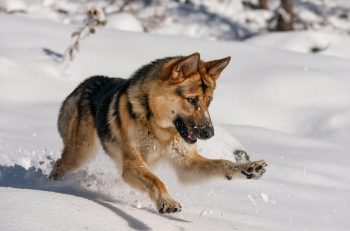As a guardian of a furry companion, understanding your dog’s needs and feelings is paramount, especially when it comes to their comfort in varying temperatures. While some signs that your dog is feeling cold, such as shivering or curling up tightly, might be easily recognizable, there are subtler indicators that could easily be overlooked. Recognizing these not-so-obvious signs is essential for ensuring your dog’s well-being, as prolonged exposure to cold can lead to discomfort, lowered immune response, and in severe cases, hypothermia. This discussion delves into seven less apparent signs that suggest your dog may be cold, aiming to enhance your insights into your pet’s non-verbal communication and ensure they remain cozy and healthy during the colder months.
1. Whining or Other Unusual Vocalizations
When dogs are cold, they might begin to whine, howl, or make other unusual vocalizations as a way of communicating their discomfort. This behavior can easily be mistaken for other needs or wants, such as hunger or the need to go outside. However, if you notice that these sounds occur more frequently in colder environments or situations where your dog might be feeling a draft, it could very well be their way of telling you they’re not feeling warm enough. Paying close attention to these vocal cues in conjunction with the surrounding temperature can help you better understand your pet’s comfort levels.
2. Hunching Over or Tucking Tail
A subtle sign that your dog is feeling cold is a change in their body posture. Dogs who are cold may hunch their backs and tuck their tails between their legs to conserve body heat. This posture minimizes the amount of their body exposed to the cold air, acting as a natural response to try and keep warm. Unlike the more obvious sign of curling up, this behavior can occur while they are standing or moving around and may not be immediately recognized as a sign of being cold.
3. Seeking Shelter or Hiding
Dogs that are cold will naturally seek out warmer environments. This might manifest as finding shelter in a covered area, hiding behind furniture, or burrowing into blankets or piles of clothes. If you notice your dog frequently seeking out these warm refuges, especially in colder months or in air-conditioned rooms, it’s a strong indicator they’re trying to escape the chill. This behavior is their instinctual way of finding comfort and warmth, similar to how wild animals burrow or seek shelter to protect themselves from the elements.
4. Slower Movements or Reluctance to Move
Cold temperatures can make your dog’s muscles stiff and reduce their willingness to move. If you observe your dog moving more slowly than usual, showing reluctance to go for walks, or hesitating to jump or play, the cold may be affecting their comfort and mobility. This sign can be particularly subtle in older dogs, who may already have joint issues that can worsen with cold weather, making it important to monitor their activity levels and provide warmth and comfort.
5. Shifting from Paw to Paw
When standing on cold surfaces, dogs may shift their weight from one paw to another or frequently lift their paws off the ground. This behavior is an attempt to reduce contact with the cold surface and prevent heat loss through their paws. It’s a clear sign of discomfort from the cold, especially noticeable in dogs who are outside during cold weather. Providing insulated footwear or ensuring they have a warm, dry place to stand can help alleviate this discomfort.
6. Increased Clinginess or Seeking Physical Contact
Some dogs may become more clingy or seek more physical contact with their owners when they are feeling cold. This behavior is not just a sign of affection; it’s also a way for them to share your body heat. If your dog suddenly seems more eager to cuddle or stays closer to you than usual during colder periods, it could be their way of seeking warmth and comfort.
7. Dry, Flaky Skin
While not an immediate sign of being cold, consistently dry, flaky skin can indicate that your dog’s environment is too dry or cold for their comfort. Cold air, both outdoors and indoors from heating systems, can dry out your dog’s skin. If you notice changes in their coat or skin condition during the colder months, it may be a sign that the air in your home is too dry and that your dog could benefit from a warmer and more humid environment.
In conclusion, understanding and recognizing these not-so-obvious signs can play a crucial role in ensuring your dog’s comfort and health during colder seasons. Each dog may express their discomfort differently, so observing your pet’s behavior and body language is key. By staying attentive and making necessary adjustments to their environment, you can help your furry friend stay warm and cozy no matter how chilly it gets outside.
The post 7 Not-So-Obvious Signs Your Dog is Cold appeared first on iHeartDogs.com.

